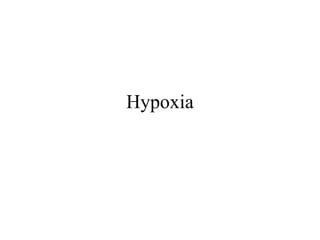
Hypoxia :types , causes,and its effects
- 1. Hypoxia
- 2. Hypoxia Oxygen deficiency at the tissue level. Anoxia: means absence of O2 at the tissue level.
- 3. Types of Hypoxia 1. Hypoxic Hypoxia - PO2 of the arterial blood is low 2. Anemic Hypoxia - Amount of Hb. To carry O2 is Low 3. Stagnant or Ischemic Hypoxia- Blood flow to the tissue is low 4. Histotoxic Hypoxia – Tissue can’t utilize O2
- 4. Causes of Hypoxic Hypoxia A. Low PO2 in the inspired air which include: 1. High Altitude 2. Breathing Gas mixture having Low PO2 3. Breathing in closed space B. Decreased Pulmonary Ventilation due to Respiratory Disorders. 1. Obstructive Lung diseases e.g Asthma 2. Mechanical or Nervous Disorders (e.g. neuromuscular disorders) 3. Depression of Respiratory centre 4. Pneumothorax (air in thorcic cavity)
- 5. Causes of Hypoxic Hypoxia C. Inadequate Oxygenation of Blood due to Respiratory Disorders Which includes: 1. Impaired alveolar Diffusion e.g. Emphysema(destruction of alvoeli) 2. Non Functioning Alveoli e.g. Fibrosis 3. Pulmonary Edema 4. Lack of Surfactant . Collapse of lungs 5. Pulmonary disease 6. Abnormal alveolar ventilation-perfusion ratio (↑ physiologic dead space) 7. Diminished respiratory membrane diffusion
- 6. Causes of Hypoxic Hypoxia D. Cardiac Disorders 1. Congestive Heart Failure 2. Venous-to-arterial shunts ("right-to-left" cardiac shunts)
- 7. Anemic Hypoxia Reduced O2 carrying capacity due to: 1 .↓ number of RBCs 2. ↓ amount of Hb 3. abnormal hemoglobin (e.g.) Met Hb
- 8. Stagnant Hypoxia Due to decreased velocity of blood flow. General circulatory deficiency 1. CCF 2. Hemorrhagic Shock Localized circulatory deficiency (peripheral, cerebral, coronary vessels) 3. Vasoconstriction (vasospasm) & 4. Thrombo-embolism
- 9. Histotoxic Hypoxia Inability of the tissue to utilize O2. 1.Cyanide (cytochrome oxidase is completely blocked. refers to a reduction in ATP production by the mitochondria due to a defect in the cellular usage of oxygen.) 2.Sulfide Poisoning 3. Vitamin B deficiency (beriberi ) tissue utilization of oxygen is compromised.
- 10. Effects of Hypoxia • death of cells On CNS • ↓ mental activity • coma • Reduced work capacity of the muscles
- 11. Cyanosis • Cyanosis means blueness of skin,and its cause is excessive amounts of deoxygenated hemoglobin in skin blood vessels. • This deoxygenated hemoglobin has intense dark blue purple color that is transmitted through skin.
- 12. Cyanosis • In general, definite cyanosis appears whenever the arterial blood contains more than 5 grams of deoxygenated hemoglobin in each 100 milliliters of blood. • A person with anemia almost never becomes cyanotic because there is not enough hemoglobin for 5 grams to be deoxygenated in 100 milliliters of arterial blood. • Conversely, in a person with excess red blood cells, as occurs in polycythemia vera, the great excess of available hemoglobin that can become deoxygenated leads frequently to cyanosis, even under otherwise normal conditions.
- 13. Central cyanosis • Central cyanosis is caused by diseases of the heart or lungs or by abnormal hemoglobin types like methemoglobin or sulfhemoglobin etc. • This is seen commonly as bluish or purple discoloration of tongue and linings of the mouth. • high altitude sickness, • pulmonary edema, • acute sever attack of asthma, • pneumothorax
- 14. Central cyanosis
- 15. Peripheral cyanosis • Peripheral cyanosis results from decreased local blood circulation in the peripheral organs, arms and legs. • Cyanosis shows up as the levels of deoxygenated blood rises in the small blood vessels of the fingers and toes. • This may be seen in heart failure, shock (sluggish or slowing of blood circulation with severe loss of blood pressure), exposure to cold temperatures and diseases of blood circulation. • Limbs appear bluish and are usually cold to touch.
- 17. Cough Reflex • The bronchi and trachea are so sensitive to light touch that very slight amounts of foreign matter or other causes of irritation initiate the cough reflex. • Afferent nerve impulses pass from the respiratory passages mainly through the vagus nerves to the medulla of the brain.
- 18. Cough Reflex • First, up to 2.5 liters of air are rapidly inspired. • Second, the epiglottis closes, and the vocal cords shut tightly to entrap the air within the lungs. • Third, the abdominal muscles contract forcefully, pushing against the diaphragm while other expiratory muscles, such as the internal intercostals,also contract forcefully. The pressure in the lungs rises rapidly to as much as 100 mm Hg or more. • Fourth, the vocal cords and the epiglottis suddenly open widely, so that air under this high pressure in the lungs explodes outward.The rapidly moving air usually carries with it any foreign matter that is present in the bronchi or trachea.
- 19. Sneeze Reflex The sneeze reflex is very much like the cough reflex, except that it applies to the nasal passageways. The initiating stimulus of the sneeze reflex is irritation in the nasal passageways; the afferent impulses pass in the fifth cranial nerve to the medulla, where the reflex is triggered.
- 20. Sneeze Reflex A series of reactions similar to those for the cough reflex takes place; however, the uvula is depressed, so that large amounts of air pass rapidly through the nose,thus helping to clear the nasal passages of foreign matter.